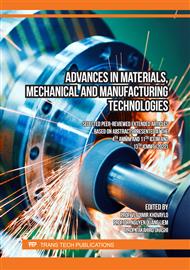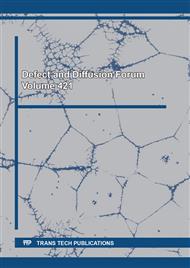[1]
Palacín, M. R., & de Guibert, A. (2016). Why do batteries fail?. Science, 351(6273), 1253292.
DOI: 10.1126/science.1253292
Google Scholar
[2]
Chen, Y., Jiang, Y., Chi, S. S., Woo, H. J., Yu, K., Ma, J., ... & Deng, Y. (2022). Understanding the lithium dendrites growth in garnet-based solid-state lithium metal batteries. Journal of Power Sources, 521, 230921.
DOI: 10.1016/j.jpowsour.2021.230921
Google Scholar
[3]
Xu, X., Wang, S., Wang, H., Xu, B., Hu, C., Jin, Y., ... & Yan, H. (2017). The suppression of lithium dendrite growth in lithium sulfur batteries: A review. Journal of Energy Storage, 13, 387-400.
DOI: 10.1016/j.est.2017.07.031
Google Scholar
[4]
Han, N., Chen, D., Pang, Y., Han, Z., Xia, Y., & Jiao, X. (2017). Structural regulation of ZnGa2O4 nanocubes for achieving high capacity and stable rate capability as an anode material of lithium ion batteries. Electrochimica Acta, 235, 295-303.
DOI: 10.1016/j.electacta.2017.03.122
Google Scholar
[5]
Zhang, H., Li, C., Eshetu, G. G., Laruelle, S., Grugeon, S., Zaghib, K., ... & Forsyth, M. (2020). From solid‐solution electrodes and the rocking‐chair concept to today's batteries. Angewandte Chemie, 132(2), 542-546.
DOI: 10.1002/ange.201913923
Google Scholar
[6]
Zhang, X., Wang, A., Liu, X., & Luo, J. (2019). Dendrites in lithium metal anodes: suppression, regulation, and elimination. Accounts of Chemical Research, 52(11), 3223-3232.
DOI: 10.1021/acs.accounts.9b00437
Google Scholar
[7]
Rajagopalan, R., Tang, Y., Ji, X., Jia, C., & Wang, H. (2020). Advancements and challenges in potassium ion batteries: a comprehensive review. Advanced Functional Materials, 30(12), 1909486.
DOI: 10.1002/adfm.201909486
Google Scholar
[8]
Zhamu, A., Chen, G., Liu, C., Neff, D., Fang, Q., Yu, Z., ... & Jang, B. Z. (2012). Reviving rechargeable lithium metal batteries: enabling next-generation high-energy and high-power cells. Energy & Environmental Science, 5(2), 5701-5707.
DOI: 10.1039/c2ee02911a
Google Scholar
[9]
Zhang, R., Li, N. W., Cheng, X. B., Yin, Y. X., Zhang, Q., & Guo, Y. G. (2017). Advanced micro/nanostructures for lithium metal anodes. Advanced Science, 4(3), 1600445.
DOI: 10.1002/advs.201600445
Google Scholar
[10]
Tikekar, M. D., Choudhury, S., Tu, Z., & Archer, L. A. (2016). Design principles for electrolytes and interfaces for stable lithium-metal batteries. Nature Energy, 1(9), 1-7.
DOI: 10.1038/nenergy.2016.114
Google Scholar
[11]
Zhang, K., Lee, G. H., Park, M., Li, W., & Kang, Y. M. (2016). Recent developments of the lithium metal anode for rechargeable non‐aqueous batteries. Advanced Energy Materials, 6(20), 1600811.
DOI: 10.1002/aenm.201600811
Google Scholar
[12]
Xu, K. (2014). Electrolytes and interphases in Li-ion batteries and beyond. Chemical reviews, 114(23), 11503-11618.
DOI: 10.1021/cr500003w
Google Scholar
[13]
Zhang, X. Q., Chen, X., Xu, R., Cheng, X. B., Peng, H. J., Zhang, R., ... & Zhang, Q. (2017). Columnar lithium metal anodes. Angewandte Chemie, 129(45), 14395-14399.
DOI: 10.1002/ange.201707093
Google Scholar
[14]
Liu, X. H., Zhong, L., Zhang, L. Q., Kushima, A., Mao, S. X., Li, J., ... & Huang, J. Y. (2011). Lithium fiber growth on the anode in a nanowire lithium ion battery during charging. Applied Physics Letters, 98(18), 183107.
DOI: 10.1063/1.3585655
Google Scholar
[15]
Stark, J. K., Ding, Y., & Kohl, P. A. (2013). Nucleation of electrodeposited lithium metal: dendritic growth and the effect of co-deposited sodium. Journal of The Electrochemical Society, 160(9), D337.
DOI: 10.1149/2.028309jes
Google Scholar
[16]
Kim, H., Jeong, G., Kim, Y. U., Kim, J. H., Park, C. M., & Sohn, H. J. (2013). Metallic anodes for next generation secondary batteries. Chemical Society Reviews, 42(23), 9011-9034.
DOI: 10.1039/c3cs60177c
Google Scholar
[17]
Peled, E., Golodnitsky, D., & Ardel, G. (1997). Advanced model for solid electrolyte interphase electrodes in liquid and polymer electrolytes. Journal of the Electrochemical Society, 144(8), L208.
DOI: 10.1149/1.1837858
Google Scholar
[18]
Xu, M., Xing, L., & Li, W. (2014). Interphases between electrolytes and anodes in Li-ion battery. In Electrolytes for Lithium and Lithium-Ion Batteries (pp.227-282). Springer, New York, NY.
DOI: 10.1007/978-1-4939-0302-3_5
Google Scholar
[19]
Monroe, C., & Newman, J. (2003). Dendrite growth in lithium/polymer systems: A propagation model for liquid electrolytes under galvanostatic conditions. Journal of The Electrochemical Society, 150(10), A1377.
DOI: 10.1149/1.1606686
Google Scholar
[20]
Wood, K. N., Kazyak, E., Chadwick, A. F., Chen, K. H., Zhang, J. G., Thornton, K., & Dasgupta, N. P. (2016). Dendrites and pits: Untangling the complex behavior of lithium metal anodes through operando video microscopy. ACS central science, 2(11), 790-801.
DOI: 10.1021/acscentsci.6b00260
Google Scholar
[21]
Kim, H., Jeong, G., Kim, Y. U., Kim, J. H., Park, C. M., & Sohn, H. J. (2013). Metallic anodes for next generation secondary batteries. Chemical Society Reviews, 42(23), 9011-9034.
DOI: 10.1039/c3cs60177c
Google Scholar
[22]
Aurbach, D., Zinigrad, E., Cohen, Y., & Teller, H. (2002). A short review of failure mechanisms of lithium metal and lithiated graphite anodes in liquid electrolyte solutions. Solid state ionics, 148(3-4), 405-416.
DOI: 10.1016/s0167-2738(02)00080-2
Google Scholar
[23]
Dornbusch, D. A., Hilton, R., Lohman, S. D., & Suppes, G. J. (2014). Experimental validation of the elimination of dendrite short-circuit failure in secondary lithium-metal convection cell batteries. Journal of The Electrochemical Society, 162(3), A262.
DOI: 10.1149/2.0021503jes
Google Scholar
[24]
Cheng, X. B., Zhang, R., Zhao, C. Z., & Zhang, Q. (2017). Toward safe lithium metal anode in rechargeable batteries: a review. Chemical reviews, 117(15), 10403-10473.
DOI: 10.1021/acs.chemrev.7b00115
Google Scholar
[25]
Lu, D., Shao, Y., Lozano, T., Bennett, W. D., Graff, G. L., Polzin, B., ... & Xiao, J. (2015). Failure mechanism for fast‐charged lithium metal batteries with liquid electrolytes. Advanced Energy Materials, 5(3), 1400993.
DOI: 10.1002/aenm.201400993
Google Scholar
[26]
Cheng, X. B., Hou, T. Z., Zhang, R., Peng, H. J., Zhao, C. Z., Huang, J. Q., & Zhang, Q. (2016). Dendrite‐free lithium deposition induced by uniformly distributed lithium ions for efficient lithium metal batteries. Advanced materials, 28(15), 2888-2895.
DOI: 10.1002/adma.201506124
Google Scholar
[27]
Peled, E. (1979). The electrochemical behavior of alkali and alkaline earth metals in nonaqueous battery systems—the solid electrolyte interphase model. Journal of The Electrochemical Society, 126(12), (2047).
DOI: 10.1149/1.2128859
Google Scholar
[28]
Ding, F., Xu, W., Graff, G. L., Zhang, J., Sushko, M. L., Chen, X., ... & Zhang, J. G. (2013). Dendrite-free lithium deposition via self-healing electrostatic shield mechanism. Journal of the American Chemical Society, 135(11), 4450-4456.
DOI: 10.1021/ja312241y
Google Scholar
[29]
Liu, W., Lee, S. W., Lin, D., Shi, F., Wang, S., Sendek, A. D., & Cui, Y. (2017). Enhancing ionic conductivity in composite polymer electrolytes with well-aligned ceramic nanowires. Nature energy, 2(5), 1-7.
DOI: 10.1038/nenergy.2017.35
Google Scholar
[30]
Han, X., Gong, Y., Fu, K. K., He, X., Hitz, G. T., Dai, J., ... & Hu, L. (2017). Negating interfacial impedance in garnet-based solid-state Li metal batteries. Nature materials, 16(5), 572-579.
DOI: 10.1038/nmat4821
Google Scholar
[31]
Takehara, Z. I. (1997). Future prospects of the lithium metal anode. Journal of power sources, 68(1), 82-86.
DOI: 10.1016/s0378-7753(96)02546-3
Google Scholar
[32]
Wen, J., Yu, Y., & Chen, C. (2012). A review on lithium-ion batteries safety issues: existing problems and possible solutions. Materials express, 2(3), 197-212.
DOI: 10.1166/mex.2012.1075
Google Scholar
[33]
Li, Z., Huang, J., Liaw, B. Y., Metzler, V., & Zhang, J. (2014). A review of lithium deposition in lithium-ion and lithium metal secondary batteries. Journal of power sources, 254, 168-182.
DOI: 10.1016/j.jpowsour.2013.12.099
Google Scholar
[34]
Ma, Q., Cui, J., Luo, J., & Dong, A. (2022). Nonreactive Electrolyte Additives for Stable Lithium Metal Anodes. ACS Applied Energy Materials.
DOI: 10.1021/acsaem.1c03333
Google Scholar
[35]
Cheng, X. B., Zhao, M. Q., Chen, C., Pentecost, A., Maleski, K., Mathis, T., ... & Gogotsi, Y. (2017). Nanodiamonds suppress the growth of lithium dendrites. Nature communications, 8(1), 1-9.
DOI: 10.1038/s41467-017-00519-2
Google Scholar
[36]
Nie, H., Zhang, C., Liu, Y., & He, A. (2016). Synthesis of Janus rubber hybrid particles and interfacial behavior. Macromolecules, 49(6), 2238-2244.
DOI: 10.1021/acs.macromol.6b00159
Google Scholar
[37]
Luo, K., Leng, Z., Li, Z., Ma, M., Li, S., Xie, W., ... & Peng, Z. (2021). Shielded electric field-boosted lithiophilic Sites: A Janus interface toward stable lithium metal anodes. Chemical Engineering Journal, 416, 129142.
DOI: 10.1016/j.cej.2021.129142
Google Scholar
[38]
Zhong, Y., Lin, F., Wang, M., Zhang, Y., Ma, Q., Lin, J., ... & Wang, H. (2020). Metal organic framework derivative improving lithium metal anode cycling. Advanced Functional Materials, 30(10), 1907579.
DOI: 10.1002/adfm.201907579
Google Scholar
[39]
Song, C. L., Li, Z. H., Ma, L. Y., Li, M. Z., Huang, S., Hong, X. J., ... & Lan, Y. Q. (2021). Single-Atom Zinc and Anionic Framework as Janus Separator Coatings for Efficient Inhibition of Lithium Dendrites and Shuttle Effect. ACS nano, 15(8), 13436-13443.
DOI: 10.1021/acsnano.1c03876
Google Scholar
[40]
Vishnugopi, B. S., Hao, F., Verma, A., & Mukherjee, P. P. (2020). Double-edged effect of temperature on lithium dendrites. ACS Applied Materials & Interfaces, 12(21), 23931-23938.
DOI: 10.1021/acsami.0c04355
Google Scholar
[41]
Hong, Z., & Viswanathan, V. (2019). Prospect of thermal shock induced healing of lithium dendrite. ACS Energy Letters, 4(5), 1012-1019.
DOI: 10.1021/acsenergylett.9b00433
Google Scholar



